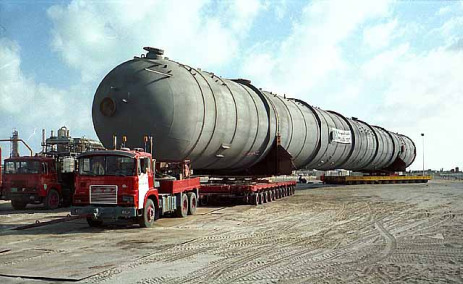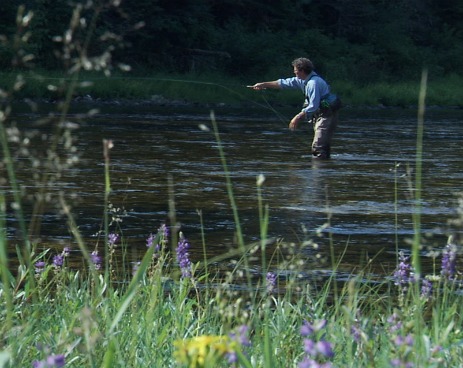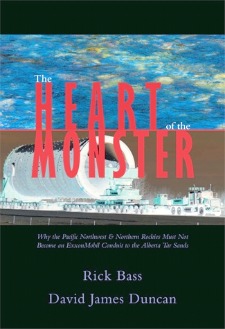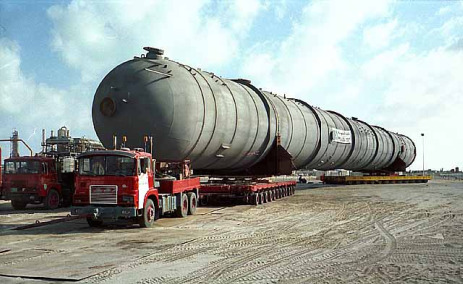 Activists in Montana and Idaho are fighting back against these monstrosities.Iconic authors and outdoorsmen David James Duncan and Rick Bass have an important new book that they wrote in response to the notorious “haul” this month of gargantuan machines (“mega-loads”) to Alberta, Canada, constructed in South Korea for use in the tar sands. Besides the tar sands being a debacle and climate justice issue, Bass and Duncan and activists are opposing this effort all along the route from a public safety and aesthetics angle too: The equipment threatens to buckle taxpayer-built roads and bridges, and if swept into the wild river corridor on the trip up Wild and Scenic Highway 12 in Montana or Idaho by an accident or avalanche, it’s unclear how it could be extricated. I caught up with Duncan as he was being featured in an upcoming episode of the PBS program Nature, called Salmon: Running the Gauntlet.
Activists in Montana and Idaho are fighting back against these monstrosities.Iconic authors and outdoorsmen David James Duncan and Rick Bass have an important new book that they wrote in response to the notorious “haul” this month of gargantuan machines (“mega-loads”) to Alberta, Canada, constructed in South Korea for use in the tar sands. Besides the tar sands being a debacle and climate justice issue, Bass and Duncan and activists are opposing this effort all along the route from a public safety and aesthetics angle too: The equipment threatens to buckle taxpayer-built roads and bridges, and if swept into the wild river corridor on the trip up Wild and Scenic Highway 12 in Montana or Idaho by an accident or avalanche, it’s unclear how it could be extricated. I caught up with Duncan as he was being featured in an upcoming episode of the PBS program Nature, called Salmon: Running the Gauntlet.
Q. David, your new book The Heart of the Monster is a fascinating and horrifying read. Can you tell me about its genesis?
A. About a year ago I learned that ExxonMobil and Imperial Oil had secretly colluded with regional politicians, and were planning to commandeer 1,100 miles of wilderness-piercing American roads and the Columbia/Snake river corridor that brings salmon and steelhead to the Interior West. One of those roads passes in front of my house and through my hometown, Missoula. Two more skirt four of my favorite wild rivers, the Blackfoot and Dearborn in Montana, and the Lochsa and Clearwater in Idaho. The more I learned, the more bizarrely inappropriate, illegal, culturally offensive, and unworkable the Exxon industrial corridor sounded. A couple in Idaho, living on the Clearwater, Lin Laughy and Borg Hendrikson, mounted a heroic resistance website called Fighting Goliath.org. I followed their postings almost daily. As a lifelong fly fisher and friend of many salmon activists, I also knew a lot about the lower Snake River dams and the monumental scam known as Northwest federal “salmon science.”
 David James Duncan in the upcoming PBS Nature documentary on the Columbia/Snake salmon crisis.Photo: Mark ShelleyMy blood was already simmering when a small Montana activist group called “All Against The Haul” asked me to write something about the issue. The “bad guys” had a two-year head start. Even working with a magazine like Orion or Outside wouldn’t get the story told fast enough to rouse resistance and possibly stop “the haul.” So I proposed a fast response book, asked for the help of two fine writers, Rick Bass and Steven Hawley, a great photographer, Frederick Ohringer, and a brilliant book designer, Ian Boyden. When the group agreed to my requests we five dove in. This was October 2010. Seven weeks later we had researched, written, edited, illustrated, designed, and self-published a substantial book. As Dylan Thomas once said after eight or so shots of whiskey, “I believe that’s the record.”
David James Duncan in the upcoming PBS Nature documentary on the Columbia/Snake salmon crisis.Photo: Mark ShelleyMy blood was already simmering when a small Montana activist group called “All Against The Haul” asked me to write something about the issue. The “bad guys” had a two-year head start. Even working with a magazine like Orion or Outside wouldn’t get the story told fast enough to rouse resistance and possibly stop “the haul.” So I proposed a fast response book, asked for the help of two fine writers, Rick Bass and Steven Hawley, a great photographer, Frederick Ohringer, and a brilliant book designer, Ian Boyden. When the group agreed to my requests we five dove in. This was October 2010. Seven weeks later we had researched, written, edited, illustrated, designed, and self-published a substantial book. As Dylan Thomas once said after eight or so shots of whiskey, “I believe that’s the record.”
Q. What is it about “the haul” that most concerns you?
A. This mega-industrial tentacle, benefiting almost no one but Big Oil, would potentially connect the Alberta Tar Sands — the largest single greenhouse gas-spewing project in world history — to the industrial nations of the Pacific Rim (Korea, Vietnam, China, etc.). It would do so via some of the most beautiful highways, tortuous mountain passes, protected wildernesses, green and recreational economies, and stunning wild and scenic rivers in the world. It would cross the lands of three sovereign Indian tribes against the will of those tribes. It would further endanger the Interior West’s salmon. It would disgrace the Nez Perce “trail of tears” — the path Chief Joseph and his people took, leading to the slaughter at the Big Hole Battlefield. And if the tar sands are fully developed, says NASA climatologist James Hansen, climate chaos will be virtually unavoidable. All this for the benefit of Big Oil. The Idaho and Montana governors invited Exxon to do their own “environmental assessment” and encouraged our departments of transportation to collude with Big Oil. No objective environmental impact statement was done. No study of the profound harm to the culture and economies already in place in this region was done. Democracy is being railroaded.
Worse, as the tar sands are developed, thousands of miles of Enbridge pipelines will cross 32 U.S. states and all 10 Canadian provinces, following or crisscrossing many of the most sensitive rivers, wildlife areas, farmlands, agricultural aquifers, and steelhead and salmon sanctuaries in North America. These pipelines are a very easy terrorist target. And they are an ongoing disaster. Enbridge pipelines have ruptured or leaked 57 times in the last year alone, including an 840,000 gallon spill that decimated biotic life and property values along the Kalamazoo River down to Lake Michigan.
Q. Where are the mega-loads now and how soon will they pass near your neighborhood?
A. Two Conoco-Philips loads, each far larger and heavier than the Statue of Liberty, attempted a trial run through Idaho beginning a few weeks ago. Both have broken traffic laws by causing delays, one scraped against a cliff-face and stalled for an hour, and the multiple delays have threatened lives, including the life of a dear friend of mine on his way to a Lewiston hospital after a cancer surgery had failed. The two behemoths are now stalled, one in Montana just over the border, one in Idaho. In response to this, Exxon — which said on record that their 207 proposed loads could not be reduced in size, and that there is no other route to the tar sands — has begun to reduce the size of 93 of their loads, and also discovered an alternate route to Alberta.
At least 114 Exxon loads are still planning to come through. But that proposal will be seriously contested, both in Idaho and Montana.
Q. How far beyond Idaho and Montana does this issue go?
A. The heavy haul, because it is a tentacle of the tar sands, is a global issue. Big Oil and the Canadian government are destroying 44 million acres of one of the Earth’s two great living “lungs,” the northern boreal forests (tropical rain forest being the other). Tar sands mining stands to slaughter between 6 million and 166 million birds. The ratification of the lower Snake River barging route by Exxon, via dams that each year slaughter endangered salmon smolts by the millions, would make the ESA even more impossible to monitor or enforce.
And that’s just the regional damage. No tar sands booster could visit the vanishing agriculture of glacier-dependent countries like Peru, Nepal, and Northern India, or of drowning island nations like Kiribati, Bangladesh, the Marshall Islands, the Maldives, and claim innocence or ignorance of the effects of their greed and destructiveness. If you know anybody with Exxon, Imperial, or Shell oil stock, tell them to get their head out of their seater-bottomus and support their children’s ability to breathe and feed wild birds.
 Q. What does the great title of the book derive from?
Q. What does the great title of the book derive from?
A. The Nez Perce people have a geographical birthplace along the lower Clearwater River — an intriguing basalt rubble heap known as “The Heart of the Monster.” There is a myth about this site that is definitely prehistoric, which I also felt could be prophetic. With permission, I reproduced the myth in our book of the same title.
At the end of a previous age of the world, a voracious monster began swallowing all the living creatures on earth — the way mega-corporations are swallowing us now.
In the end, the monster swallowed just about everybody but Old Man Coyote. The wily old boy got lonely. So he cleaned himself up, tried to look sexy and tasty, and sure enough, the monster swallowed him, too. But you know Coyote. He snuck five stone knives and some fire-starting materials into the monster’s gut with him. He then set about heating the monster’s heart, cooking it while he sawed at it. It was hard work. He broke all five blades. But in the end the monster’s heart collapsed and imploded. The basalt formation by the Clearwater, according to the Nez Perce, is that old dead imploded monster heart.
With Big Oil megaloads far larger than the Statue of Liberty passing within a few hundred feet of this ancient site, it wasn’t hard for me to make a connection when I stood by the imploded heart last fall. The mega-corporations are monstrous by definition. It is illegal for them to be moral. Theirs is the devouring appetite of a bottom line divorced from biological and spiritual reality. The Coyote in all of us has no choice: We must heat and saw away at the heart of the new monster, “corporate personhood,” until the effing thing implodes.
Our book is a bit of that heating and sawing operation.
David James Duncan and Rick Bass will be part of a call on Tuesday, March 1 to discuss “the haul,” the tar sands, and the grassroots opposition. Folks are invited to join and ask them their own questions about this issue.




